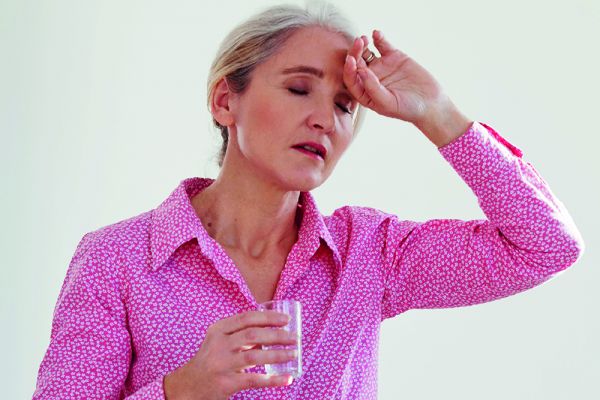
The WHI study measured the most severe, life-threatening outcomes: breast cancer, heart disease, stroke, and blood clots, among others. But for a woman who is constantly losing hair, who has joint pains, who suddenly finds that her smell has changed (and not for the better), or who is depressed or exhausted — for many of these women, the net benefits of taking hormones are day-to-day Experiencing an improved quality of life day after day may be worth accepting the additional risks of hormone therapy even after the age of 60. Hormones can also be useful for women like me, whose symptoms are not as severe but whose risks are low. “I’m not saying every woman needs hormones,” says Rubin, “but I do believe in your body, your choice.”
Talking about menopause, among so many other things, lacks the language that helps us make those decisions. Some women sail happily into motherhood, but there’s a term for the extreme anxiety and depression that other women experience after childbirth: postpartum depression. Some women menstruate every month without major upheavals; others experience mood swings that disrupt their daily functioning and suffer from what is known as premenstrual syndrome (PMS) or, in more severe cases, premenstrual dysphoria. A significant proportion of women experience no symptoms at all during menopause. Others suffer near-systemic collapses with brain fog, recurring hot flashes, and exhaustion. Others feel different enough to know they don’t like what they’re feeling, but they’re hardly incapacitated. Menopause—that vague term—is too big, too overdetermined, and creates a confusion that makes it particularly difficult to talk about.
No symptoms is more closely associated with menopause than hot flashes, a phenomenon often reduced to a comedic expression — the middle-aged woman angrily waving a fan in front of her face and tossing ice cubes into her shirt. Seventy to 80 percent of women experience hot flashes, yet they’re almost as mysterious to researchers as they are to the women who experience them — a reflection of how much we still have to learn about the biology of menopause. Scientists are now trying to figure out if hot flashes are just a symptom or if they trigger other changes in the body.
Curiously, a woman’s searing heat is not reflected in a significant increase in her core body temperature. Hot flashes originate in the hypothalamus, an area of the brain rich in estrogen receptors that is both vital to the reproductive cycle and acts as a thermostat. Without estrogen, his thermostat is now jiggling, and the hypothalamus is more likely to misinterpret small increases in core body temperature as too hot, triggering sweating and widespread dilation of blood vessels to cool the body. This also drives up the temperature on the skin. Some women experience these misfires once a day, others 10 or more, each lasting from seconds to five minutes. On average, women experience them for seven to ten years.
What hot flashes can do for a woman’s health is one of the main questions Rebecca Thurston, director of the Women’s Biobehavioral Health Laboratory at the University of Pittsburgh, is trying to answer. Thurston helped lead a study that followed a diverse cohort of 3,000 women over the age of 22 and found that about 25 percent of them were what are known as superflashers: Their hot flashes began well before their periods became irregular, and the women continued to experience them until then to 14 years of age, which turns the notion on its head that hot flashes are an irritating but short-lived inconvenience for most women. Of the five racial and ethnic groups Thurston studied, it was found that black women experienced the most hot flashes, found them the most annoying, and endured them the longest. In addition to race, low socioeconomic status has been linked to the duration of hot flashes in women, suggesting that living conditions may affect how the body copes with menopause years later. Women who were abused in childhood were 70 percent more likely to report night sweats and hot flashes.
Could these symptoms also indicate harm beyond the impact on a woman’s quality of life? In 2016, Thurston published a study in the journal Stroke that showed women who had more hot flashes — at least four a day — tended to show more signs of cardiovascular disease. The association was even stronger than the association between cardiovascular risk and obesity or cardiovascular risk and hypertension. “We don’t know if it’s causal,” Thurston warns, “or in which direction. We need more research.” There might even be some women for whom hot flashes accelerate physical damage and others who don’t, Thurston told me. At the very least, she says, reports of severe and frequent hot flashes should prompt doctors to take a closer look at a woman’s heart health.
While Thurston was attempting to determine the effects of hot flashes on vascular health, Pauline Maki, a professor of psychiatry at the University of Illinois at Chicago, made connections between hot flashes and mild cognitive changes during menopause. Maki had already found a clear correlation between the number of hot flashes a woman had and her memory performance. Maki and Thurston wondered if they would be able to discover a physical representation of this association in the brain. They started with a study published last October that found a strong correlation between the number of hot flashes a woman has while sleeping and signs of damage to the brain’s tiny vessels. At a Pittsburgh lab that has one of the most powerful MRI machines in the world, Thurston showed me an image of a brain with tiny lesions shown as white dots, ghostly absences on the scan. Both their number and placement, she said, are different in women with high numbers of hot flashes. But whether the hot flashes caused the damage or the changes in the cerebral vessels caused the hot flashes, she couldn’t say.











